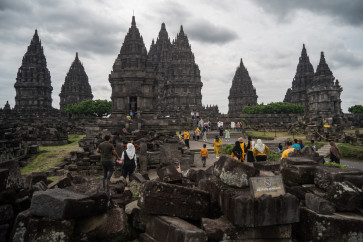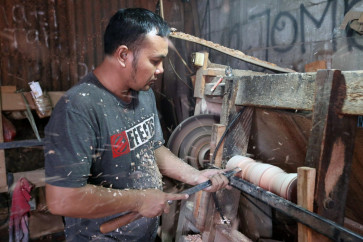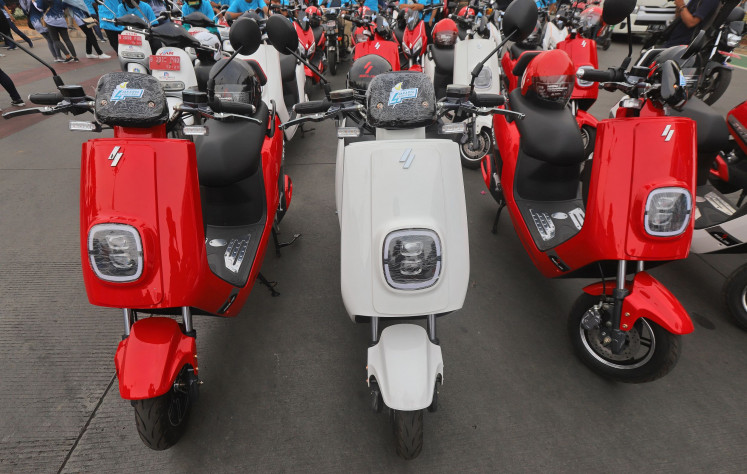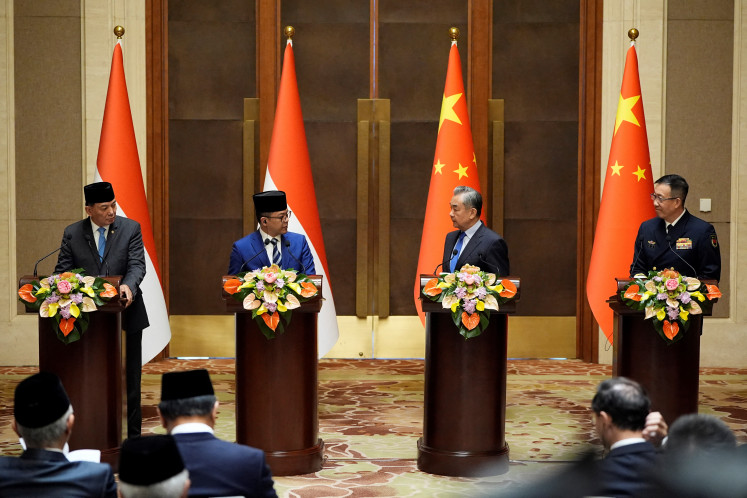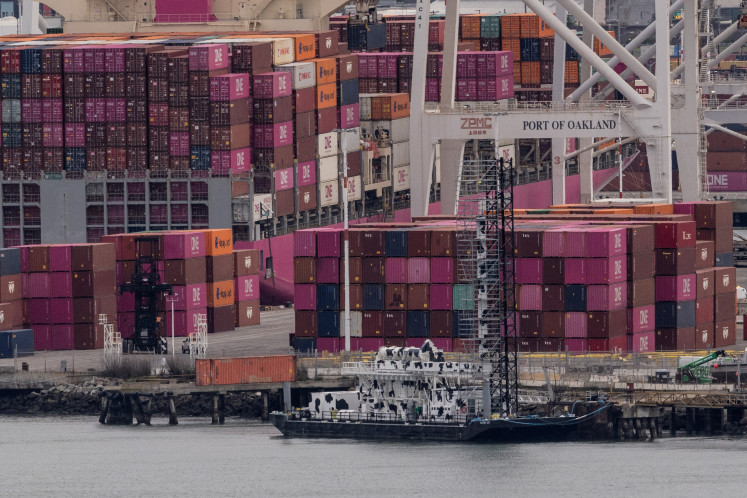The death of ‘last modernist’ Han Awal, great loss for Indonesia
Change text size
Gift Premium Articles
to Anyone
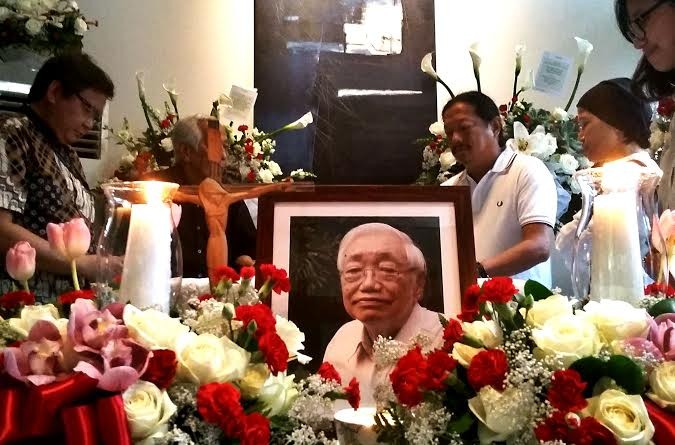 Yori Antar (third right) stands with other mourners beside the coffin of noted architect Han Awal, 85, in Kemang, South Jakarta, on May 16. Han Awal passed away on May 14. (thejakartapost.com/Ida I. Khouw)
Yori Antar (third right) stands with other mourners beside the coffin of noted architect Han Awal, 85, in Kemang, South Jakarta, on May 16. Han Awal passed away on May 14. (thejakartapost.com/Ida I. Khouw)
S
ome admired Han Awal as a heritage conservationist; others said he was a conservative modernist; media christened him a legendary architect and all agreed his death at the age of 85, on May 14, was a great loss for Indonesia.
The award-winning architect passed away peacefully in his sleep “at home, beside his beloved wife,” his son Yori Antar said at his family’s house in Kemang, South Jakarta.
Han was best known for his conservation works and his legacy can be seen in the landmarks and heritage of many cities around the country, including Jakarta.
"The beauty of an old building lies in its details," Pak Han told me in early 2000 during an interview for Save Old Batavia, my (then) weekly column on Jakarta heritage published in The Jakarta Post.
With his typical soft voice and warm personality the Dutch-and-German educated architect taught me to pay attention to the beauty of bevel glass, stained glass, carvings, workmanship and many other elements that constitute the charm of old buildings.
Senior archeologist Mundardjito remembered the father of four children and seven grandchildren as a person who was willing to listen, accommodative of different opinions and soft-spoken in upholding or defending his principles.
“His personality was key to the synergy between architecture and archeology during the conservation of the Gedung Arsip Nasional [National Archives building in West Jakarta],” said Mundardjito who was also involved in the US$ 2 million project that was funded by the Dutch business community as a 50th Indonesian Independence anniversary gift in 1995.
“Pak Han’s virtue was consistent in every project we worked on together, even when we engaged in hot debate,” the member of the Jakarta Cultural Heritage Expert Team added.

Han and his colleagues Cor Passchier and Budi Lim received the Award of Excellence in the 2001 UNESCO Asia-Pacific Awards for Cultural Heritage Conservation for the conservation of the 18th-century National Archives Building, a mansion once occupied by the VOC Dutch East Indies Company’s governor-general Reinier de Klerk, considered the last remaining example of a “closed Dutch style” country house in Indonesia.
The delicate project also won the Indonesian Architect Association (IAI) Award upon its completion in 1999.
Han’s first restoration project was the neo-gothic Jakarta Cathedral in 1987, followed by the revitalization of the Bank Indonesia building in Kota, Jakarta, into a museum, a project which won the IAI Jakarta Award in 2009; followed by similar Bank Indonesia building projects in Manado, South Sulawesi, Yogyakarta and Semarang in Central Java, among others; and the ongoing restoration of the iconic neo-classical Immanuel Church, formerly Willemskerk, in Gambir, Central Jakarta.
Even though he was well-known as a conservationist architect, Han, who was also a lecturer at the University of Indonesia in Jakarta, the Soegijapranata Catholic University in Semarang, Central Java, and at the Malang Merdeka University in Malang, East Java, embraced modernism for his own style.
“My father was a very conservative modernist architect. He always stressed aspects of functionality and simplicity in design. He never used ornaments because, for him, beauty emerged in simplicity,” said Yori who is also an award-winning architect.
Han’s original masterplan of the Atma Jaya Catholic University campus in Central Jakarta in 1962 emphasized the tenets of modernism.
It was a challenge for young architect Han Hoo Tjwan, who had only just returned to Indonesia from Germany, having graduated in 1960, when first President Sukarno asked him to contextualize modern-style design in tropical Indonesia.
He created the simple contemporary — in its era — functional, flat-roof campus that was adapted to the tropics as well as sufficiently frugal for the context of (then) poor Indonesia; while the construction was 30 meters behind the Building Line Restriction so as to allow maximum view of the Semanggi flyover, according to urbanist Marco Kusumawijaya.
Han planned open spaces for whole ground floor, where students could interact to broaden their social-political senses.
Some 30 years later the campus witnessed the student political movement that initiated the fatal May 1998 tragedy, which led to the downfall of the dictator President Soeharto, and later became the hotspot of the Semanggi I violence (Nov. 11 to 13, 1998) where 17 civilians and students were shot by the armed forces, and the Semanggi II tragedy (on Sept. 24, 1999) where nine people were killed.

“Pak Han told me [the Atma Jaya project] was the best moment in his career,” said Bambang Eryudhawan, chairman of the Jakarta Restoration Team (TSP).
The Atma Jaya campus design won the IAI Award in 1984.
However, according to Marco, “Han’s modernism was not spectacular or superstar. [His is] average modernism [but] well practiced with completely-trained skill and ingrained professional ethics,” he wrote in his blog.
Marco said the recipient of the IAI Lifetime Achievement Award in 2012 had a broad opportunity to implement his true spirit of modernist honesty and simplicity in the orthodoxy of Catholic Church bodies, his main clients in the past.
A devout Catholic, Han committed to build hundreds of churches and related public-service buildings like St. Carolus Hospital in Central Jakarta and Pangudi Luhur Catholic senior high school in South Jakarta.
But Han was also known for his involvement in the design of the Conference of New Emerging Forces (Conefo) building between 1964 and 1972, the present Parliament complex in Central Jakarta, as well as hundreds more government and private offices.
According to his son, Han never had ambition to create a spectacular legacy. “For him, monumental legacy lied in the functional aspect of anything he built,“ said Yori, who is known for his work in restoring customary buildings across the Indonesian archipelago.

Han Awal, who received the Satya Lencana Kebudayaan prestigious honor from the government in 2013 for his involvement in building, renovating, restoring or conserving some 500 public and private owned buildings throughout his lifetime, with no record of breaching the architectural code of ethics.
“I never heard anything related to him breaching the code of ethics,” said Marco, “not all architects are as clean as Pak Han”.
Born on Sept. 16, 1930, in Malang, East Java, “Han Awal was a person raised between two worlds,” said his friend and colleague Cor Passchier, former vice-president of the Royal Society of Dutch Architects (BNA).
In the late Dutch colonial period (ended in 1945) Han followed Dutch schools and later studied architecture at the Technische Hogeschool Delft in the Netherlands from 1950 to 1957, under scholarship from the Malang Catholic Church diocese.
Together with fellow Indonesian students, Han chose to leave Delft due to the ongoing political dispute between Indonesia and the Netherlands over competing claims for Irian Barat (now Indonesia’s Papua and West Papua) that occurred between 1950 and 1962. He completed his study at the Technische Universität, Facultät für Architectur, West Berlin, in 1960.
“With such a broad background he could make himself understood in several languages besides Bahasa Indonesia; in English, French, German and Dutch,” wrote Passchier, who is also an IAI honorary member, in an email sent from the Netherlands.
The person whom Passchier described as a “great and wise man” was indeed active in parting his skill, knowledge and wisdom through the clubs, associations and interest groups he initiated.
Eryudhawan recalled how Han supported the establishment of Young Indonesian Architects (AMI) in 1989 as “an un-patronizing guru”.
While, for the Architecture Documentation Center (PDA) staff, the center’s co-founder left them with a “memory of a humble man who treated human beings equally,” said Eko Mauladi, the PDA’s librarian.
The last initiative of the winner of the A. Teeuw Award in 2007 for his merits in improving cultural relations between Indonesia and the Netherlands, was the planned establishment of Heritage Watch, triggered by concern regarding the possible destruction Kota Tua heritage, during the ongoing eviction of Pasar Ikan in North Jakarta, located within the protected heritage boundary.
“He can never sign the deed for the establishment of the watchdog,” said archeologist Mundardjito, deep in grief beside the coffin containing Han’s body on May 16.
The noted archeologist recalled how Han told some people that he had wished to pass away without burdening his loved ones. “It seemed he knew his time was limited and he wanted to keep active until the last day,“ he added.
“He got what he wanted,” Yori said, adding that his father suffered heart problem. “He died while still involved in several projects”.
Husband of Anastasia Maria Theresia Gandasubrata (Gan Lian Hwa), and father of Paulus Rachmat Trisna Awal, Gregorius “Yori” Antar Awal, Maria Daryati Awal, and Maria Widyati Awal, Han was cremated at the Oasis Lestari Crematorium in Tangerang, Banten, on May 18.
“Han Awal, the last modernist, has headed toward the light,” wrote Marco.

